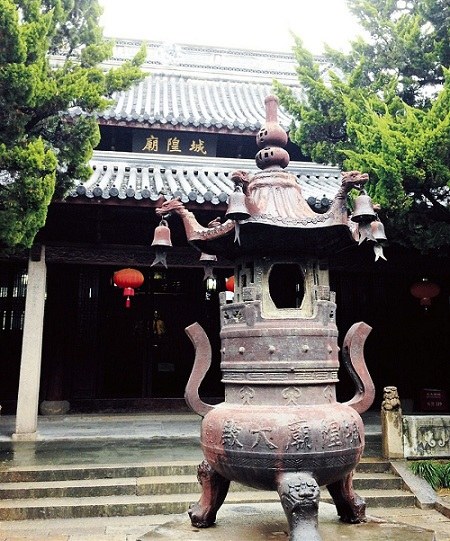
Qiuxia Garden also features the Chenghuang Temple, where locals practice Taoist rites twice during each lunar month.(Tan Weiyun)
Editor's note
Suzhou is famous for its classic Chinese gardens, but one doesn't have to leave home to appreciate the tranquility and grandeur of gardens that once attract-ed and inspired scholars and artists. This series will visit the most famous classic gardens in Shanghai — a panoply of pavilions, ponds, ancient trees, sculptures, flowers and rockeries right on our doorstep.
Hidden in a humble old lane and overshadowed by the noise of a nearby commercial street, Qiuxia Garden in suburban Jiading District doesn't attract as much attention as it deserves. This somewhat neglected site is one of Shanghai's five surviving ancient gardens.
Like a typical Suzhou-style garden, Qiuxia is not particularly large, covering an area only a little larger than three football pitches. But size is deceiving, and it's easy to get lost in the garden's zigzagging cobble pathways, dead ends, rockeries with deep caves, lush bamboo forests and sprawling corridors. One or two stray cats may pop up unexpectedly from the tall grass, giving visitors a fright.
A rainy autumn day is an ideal time to visit Qiuxia Garden. The clear, crisp autumn winds dye the garden's famed maple trees a flaming red, and the bamboo takes on a greener sheen in fine drizzle. Take a window seat in the lakeside teahouse and you can idle away the time chitchatting with the old waiter there, who speaks only local Jiading dialect but is always happy to share the garden's history with customers.
Established in 1502, Qiuxia Garden was once the private residence of Gong Hong, minister of public works in the Ming Dynasty (1368-1644). In 1582, local scholar Jin Zhaodeng built his own garden alongside Gong's. It featured a lotus pond and a bamboo forest.
In 1654, with the decline of both families, the two gardens were merged and sold to a salt trader surnamed Wang. He called the site Qiuxia Garden, meaning "autumn's sunset glow." In 1726, Wang's descendants bestowed the garden to Jiading's Chenghuang (City God) Temple as a shrine for locals to hold religious events.
After centuries of warfare and political upheaval, Qiuxia Garden was confiscated by the government and opened to the public in 1979, after two renovations.
Today, it features both a classic garden and also the Taoist Chenghuang Temple, where locals worship on the first and fifth days of a lunar month.
The temple is the first complex to greet visitors at the entrance of the garden. Red candles and joss sticks flicker, and smoke curls lazily into the air. The temple is a place of peace and holiness.
According to the Taoist beliefs, Chenghuang is the god of water and soil, who protects the land and the people living on it. The temple's main hall stands more than 52 meters high and is carved with animals and the Eight Immortals on its roof ridges. Eighteen stone lions ring the hall, fending off evil spirits.
Visitors can discover their personal god of protection, using their lunar birthdays and the 60 constellations and 12 zodiac sculptures that local artist Pan Yunxing created.
A turn past the temple is the Chishang Pavilion, built between 1821 and 1850. In the courtyard, a century-old osmanthus tree still blooms, emitting sweet scent.
The pavilion leads to a kiosk shaped like a boat. It's called the Early Boat and was constructed in the traditional architecture of ancient Chinese gardens. The boat symbolized the host's ambition to travel around the world and pursue a life of freedom and fun. The kiosk's bow section was made from natural lake rocks rarely seen in a garden of this kind.
The highlight is a ceiling-high mirror that reflects the landscapes of the northern bank and the southern hill. It is another clever architectural device of a Chinese garden — juxtaposing reality with the virtual world by bringing distant landscapes nearer.
From the boat kiosk, a cobblestone path leads to the Conggui Pavilion. Visitors should take care not to walk too quickly or they might miss three old stones from the Ming Dynasty. Each about two meters high, the three stones are nature's inscription of the Chinese characters for blessing, fortune and longevity.


















































